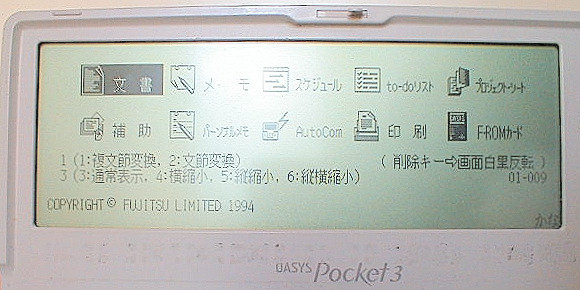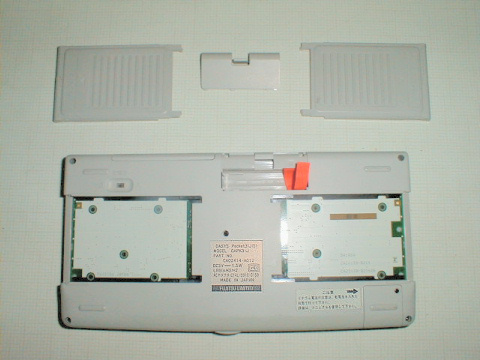 The appearance of Pocket3 is carrying out gray which became it dirty.
The appearance of Pocket3 is carrying out gray which became it dirty. In fact, it is a marble pattern. But, It is regrettable that it is not visible not much so.
It is the mobile & pocket type word processor of the formal name "OASYS Pocket3."
It is the 3rd generation of OASYS Pocket series.
It was put on the market in June, 1994.According to the personal OASYS series table, it became a production end in September, 1998.
By having carried MS-DOS unlike the founder and the 2nd generation, there are also many people by whom it is used as a small and lightweight DOS machine or a communication terminal, and me too.
According to the well-informed sources of FUJITSU, the maintenance end of OASYS Pocket 3 is in March, 2006. That is, even if it breaks after it, FUJITSU does not correct. It is very regrettable.
 The appearance of Pocket3 is carrying out gray which became it dirty.
The appearance of Pocket3 is carrying out gray which became it dirty.
In fact, it is a marble pattern. But, It is regrettable that it is not visible not much so.
 Reverse. They are two FROM card slots to right and left, a battery box is in the upper part, a lithium battery box is located in the lower right, and there is a main switch in the upper left.
Reverse. They are two FROM card slots to right and left, a battery box is in the upper part, a lithium battery box is located in the lower right, and there is a main switch in the upper left.

Back. A large terminal is a parallel port. And the terminal of the smaller one is a serial port. Each terminal is original small size. Probably, it will be difficult to get a third party product.
Since a parallel port is only an output, it has nothing which connects at least a printer.
It is about a maximum of 19200bps of speed of a serial port. However, substantially, it is about 4800 to 9600bps in speed in many cases.
Moreover, an external floppy disk drive is connected through a serial port. At this time, it is about 38400bps in speed by work of a device driver. However, it is absurdly late too.
 If a lid is opened, an oblong liquid crystal display and the keyboard which occupies even the end of a case appears.
If a lid is opened, an oblong liquid crystal display and the keyboard which occupies even the end of a case appears.
Lower Pocket3 is my machine. It is very often used. In addition, the seal stretched under the LOGO of FUJITSU on the right-hand side of a display is what was got from the friend, and is a mere joke. Actually, although Intel may enter, CPU currently used is a thing compatible with 80286.
An upper machine is a younger brother's machine. It is used rarely. And it is almost the reserve machine of my machine in fact.


After entering in the 21st century, Pocket1 and Pocket2 were able to come to hand. Then, the photograph was taken. Smart?
It is Pocket, Pocket2, and Pocket3 from the left that three are located in a line.
Pocket2 may be used before. However, it had taken out to trade-in at the time of Pocket3 purchase. Surely, the new article was purchased for about 100,000 yen. And it took out to trade-in for 22,000 yen. But it purchased for only 500 yen from the junk store this time.
Pocket1 was transferred to me among individuals for nothing.
Mr. Perry, thank you
 Although the back light is not attached, the liquid crystal screen of Pocket3 has done it quite legible. A screen is the length of 12 lines, and width 80 column. One character is 8x16 dots. In DOS mode, the reduction display of 8x8 (25 lines) can be used by introducing freeware called ECS. It is not dissatisfied in liquid crystal. Visibility is also included in. When it dares look for a dissatisfied part, it is that a view angle is very large. Therefore, it is easy to show in a train etc. from near one.
Although the back light is not attached, the liquid crystal screen of Pocket3 has done it quite legible. A screen is the length of 12 lines, and width 80 column. One character is 8x16 dots. In DOS mode, the reduction display of 8x8 (25 lines) can be used by introducing freeware called ECS. It is not dissatisfied in liquid crystal. Visibility is also included in. When it dares look for a dissatisfied part, it is that a view angle is very large. Therefore, it is easy to show in a train etc. from near one.

Keyboard. The ease of using of this keyboard is the charm of Pocket3, whatever it may call it. The ease of using of this keyboard is the maximum charm of Pocket3. The keyboard which is easy to input rather than Libretto or HP200LX is the greatest advantage. It may be easy to input Pocket3 rather than a notebook PC. I think that only the keyboard of a mobile gear is superior to this one.
 Card slot. Left side is A slot and right side is B slot.
Card slot. Left side is A slot and right side is B slot.
The lid of a slot has a form like a tray. And after putting a card there, it inserts in a main part. This lid looks weak. And it is likely to break simply or to lose.
In a happy thing, after I buy it, I will not break or lost for five years or more.
 If a card slot is removed, the printed circuit board (mother board) of a main part will be exposed.
If a card slot is removed, the printed circuit board (mother board) of a main part will be exposed.
Two AA(UM3) size battery go into a battery box.